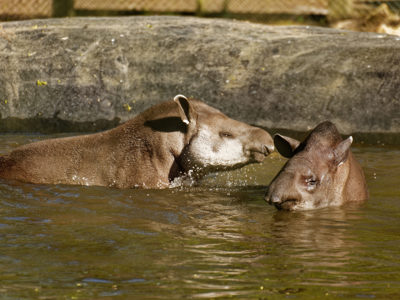
Lowland Tapir
Lowland tapirs are dark brown with lighter patches around their cheeks, throat and ears. They are stockier than other species of tapir due to the thick mane of fur that extends down their back. It is thought that this mane acts to protect them from predators, like jaguars, who target the neck area when hunting. Like all tapirs, they have an extended nose and upper lip giving them a long, movable snout.

Between dawn and dusk, lowland tapirs stay hidden in thick bushes. They emerge at night and travel familiar routes searching for food. Tapirs are excellent swimmers and spend long amounts of time wallowing in mud to remove parasites. They will also walk along the river bed to search for aquatic plants.
Lowland tapirs only come together for mating. Males make clicking and squealing noises to attract the female. When the infants are born they have a dark brown coat covered in stripes and spots. This acts as camouflage in the dim forests. The pattern is lost by 18 months old when they are fully grown.

Their diet consists of leaves, fruit and crops such as cane and cocoa. They are particularly fond of salt and will actively search it out. The long snout is used to reach for leaves and pull them close for eating.
The main threats to the Lowland tapir are habitat loss and hunting. Being large makes it particularly hard for tapirs to survive in small, fragmented areas of forest. Tapirs are hunted for meat throughout their range. Hunters use the well worn paths created by the tapir to hunt them down and stake out regularly visited locations (such as salt rich areas).
Key Facts:
Conservation Status: Vulnerable
Distribution: Argentina, Bolivia, Brazil, Colombia, Ecuador, French Guiana, Guyana, Paraguay, Peru, Suriname, Venezuela
Habitat: Swamp Forest, Tropical Forest
Diet: Fruit, Herbivore, Leaves
Weight: 225 – 250kg
Gestation: 335 – 439 days
No. of young: 1
Life Span: 30 years

SUPPORT OUR ANIMALS
If you're looking for an alternative way to donate to Twycross Zoo, you can help support our animals and our zoo keepers by purchasing something from our Amazon Wishlist!
Updated regularly by our zoo keepers, the items on the list help to provide enrichment for our animals and keep their habitats well maintained.
Every donation helps us as a conservation charity.
